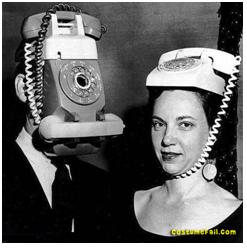 Yesterday, I gave you a guided tour of how Jacobs Media ended up becoming major proponents and practitioners of web-based audience research.
Yesterday, I gave you a guided tour of how Jacobs Media ended up becoming major proponents and practitioners of web-based audience research.
Today, there’s some interesting evidence to share that suggests that because of population shifts, landline erosion, and the mobile phone explosion, a version of web-based methodology may actually be more accurate than telephone studies.
I can tell you for the last eight years, a number of media research pros have questioned me about the validity and efficacy of our studies. I have never misrepresented them – they are a look at a station’s database members, biases and all. But like research in the political arena that seeks out the all-important “likely voters,” sampling from a radio station’s email database produces these same types of consumer VIPs.
They signed up for your email club for one reason or another. And chances are, they’re pretty core radio listeners – or at least they were at one time. We’re measuring how broadcast radio continues to entertain and inform this important segment of the audience, and how they use other media. In essence, if these listeners are being impacted or distracted by social media, Internet pure-plays, and second screens, stations may feel it in the ratings.
And our Techsurveys have successfully called some very important trends – the 50% level of smartphone ownership, the dominance of Facebook, the emergence of Twitter, the death of the clock radio, and the explosive growth of tablets. These are all important changes that affect just about every broadcaster. And in many cases, there are actions steps that stations can take to defend against or participate in.
Would a broadly selected telephone sample be more accurate?
That’s the question that many people in the political community were asking last fall. Gallup ended up using a combination of landline and cell phone sample frames. Many other political pollsters ended up aggregating many different polls in order to come up with a composite trend of likely voters and how they might behave on Election Day.
 But one of the more interesting stories involved SurveyMonkey – an online polling company that we have used for a number of web projects, as I’m sure many people reading this blog have done. Like our surveys, their polling amasses huge numbers of people. The day before Election Day, more than 60,000 people responded to one of their surveys. More than a million people were included in their Presidential polls from August though Election Day.
But one of the more interesting stories involved SurveyMonkey – an online polling company that we have used for a number of web projects, as I’m sure many people reading this blog have done. Like our surveys, their polling amasses huge numbers of people. The day before Election Day, more than 60,000 people responded to one of their surveys. More than a million people were included in their Presidential polls from August though Election Day.
To get a sense for whether online surveys have credibility, listen to Nate Silver, author of the wildly quoted FiveThirtyEight political blog. Silver has emerged as perhaps the biggest winner from last fall’s elections, based on his accurate predictions. Here’s one of his recent thoughts about the telephone versus online surveys:
“When people are asked questions by a person, they feel like they should make a choice.”
A SurveyMonkey VP, Philip Garland, agreed that consumers are actually more open when taking an Internet survey, and perhaps more honest.
From Arbitron to Nielsen to the many radio research firms to my company, the media world is being rocked by the rapid way in which consumers are changing, moving, morphing, and falling out of predictable patterns of conformity and behavior.
The digital transition impacts survey research, too. When we started our web surveys back in the ‘90s, we didn’t think we were especially cutting edge.
Today, we’re not so sure.
It’s not too late to join more than 250 North American radio stations and sign-up for Techsurvey9.
- Media And Technology In 2025: Believe It Or Not! - April 18, 2025
- In Radio, You Just Never Know - April 17, 2025
- The Secret To Making A Great Podcast (And Great Radio) - April 16, 2025




Interesting post. Its’ a good example of one door closing and another opening. Do you think this trend applies to web based music and perceptual research too? Is there a place for it? Is it potentially more accurate given the growing number of cell phone only households and issues reaching them…or is the ideal now a mix of methodologies?
I think what you’re talking about is already (quietly) happening at research companies – inside and outside of radio. It is getting more difficult to reach consumers on the phone (Do Not Call Registry, Caller ID, etc.), and calling them on mobile phones is rife with problems – and expense. It is moving to the web, and given more stories like this one for SurveyMonkey, I believe you’re going to see more rapid movement to online research. It’s far from perfect and its own biases, but the combination of wide reach at a low costs is seductive. Thanks, Bob.